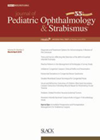
Journal Reviews
Secondary glaucoma post paediatric cataract surgery
This retrospective observational consecutive case series assessed the incidence and risk factors associated with developing glaucoma after paediatric cataract surgery with primary intraocular lens (IOL) implantation. They reviewed 136 children (199 eyes) who underwent paediatric cataract surgery before the age...
Retinoblastoma in older children
Retinoblastoma is the most common ophthalmic malignancy in childhood and over 90% are diagnosed before the age of five years. It is not often suspected in older children given its rarity and unusual clinical findings which complicates the diagnosis. The...
Ophthalmology practice during COVID-19
The purpose of this study was to share the experiences in treating paediatric ophthalmology patients during the pandemic and to report institution guidelines. A flowchart was devised for telephone triage and subsequent follow-up of patients through telemedicine or face to...
Refractive changes over time for fully accom esotropia
The purpose of this study was to determine refractive error changes across time and to define factors contributing to decompensation in patients with fully accomodative esotropia (FAET). This was a retrospective study of 223 patients with a mean age at...
Retinoblastoma risk factors for recurrence
This study evaluates risk factors for local tumour recurrence of main solid tumour, subretinal seed, vitreous seed and new tumour formation in eyes with retinoblastoma (RB) management with primary chemotherapy over 20 years of follow-up. The study included 960 eyes...
Resident versus supervising surgeon differences
The purpose of this study was to compare surgical operating times and complication rates in strabismus surgery undertaken by one attending surgeon versus 10 supervised residents (most first year). Operating time was a mean of 35.5 ±6 minutes for residents...
Microperimetry measurements in anisometropic amblyopia
The authors aimed to evaluate retinal sensitivity and fixation characteristics in children with anisometropic amblyopia by macular analyser integrity assessment (MAIA) microperimetry and to compare the results between amblyopia and fellow eyes. The study included 39 children; 21 female –...
Mobile phone use with esotropia development
This study analysed clinical characteristics and surgical outcomes in patients with acquired comitant esotropia (ACET) and determined the prevalence of excessive mobile touch screen device use in these patients. This was a retrospective study of 35 patients of which three...
Greater accuracy of cycloplegic refraction
The authors conducted this study on 5320 pre-school (four to six-year-old) and 6475 school (seven to ten years) children to compare the results of final glasses prescription based on cycloplegic refraction with atropine to those of non-cycloplegic refraction. For younger...
IOL effect on refraction
The authors aimed to evaluate the effect of age at primary intraocular lens (IOL) implantation on the rate of refractive growth during childhood. This was a retrospective study of 296 eyes of 219 patients. Forty-six met inclusion criteria; 28 unilateral...
ROP screening criteria
This study aimed to describe a process of identifying birth weight and gestational age screening guidelines in Mongolia using telemedicine for retinopathy of prematurity (ROP) screening. This was a single centre prospective study collecting data from December 2016 to January...
Outcomes of early versus late surgery for infantile esotropia
The authors aimed to provide a better understanding of the clinical spectrum of infantile esotropia by comparing motor and sensory results in the long-term follow-up of patients who underwent surgery. This was a retrospective review over a 17-year period. There...







